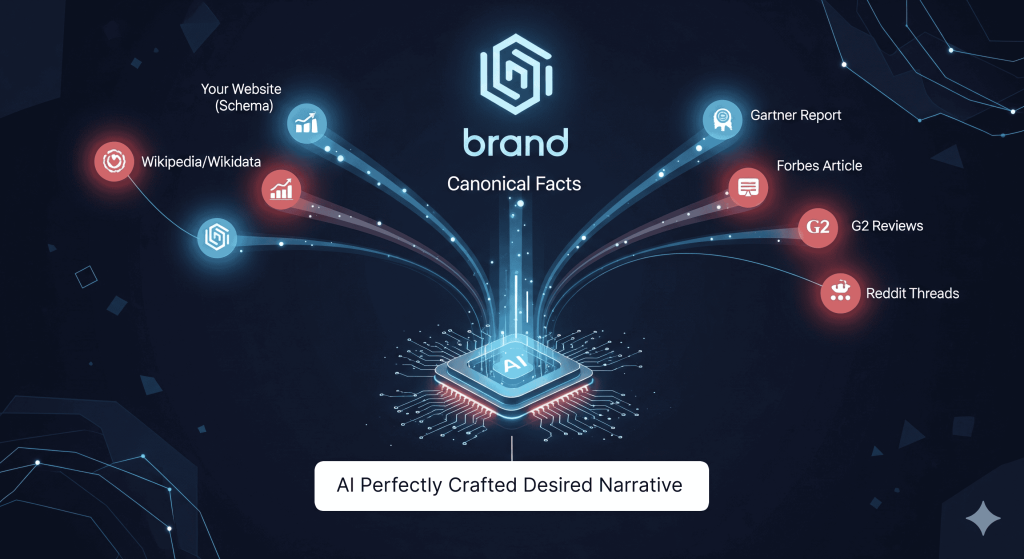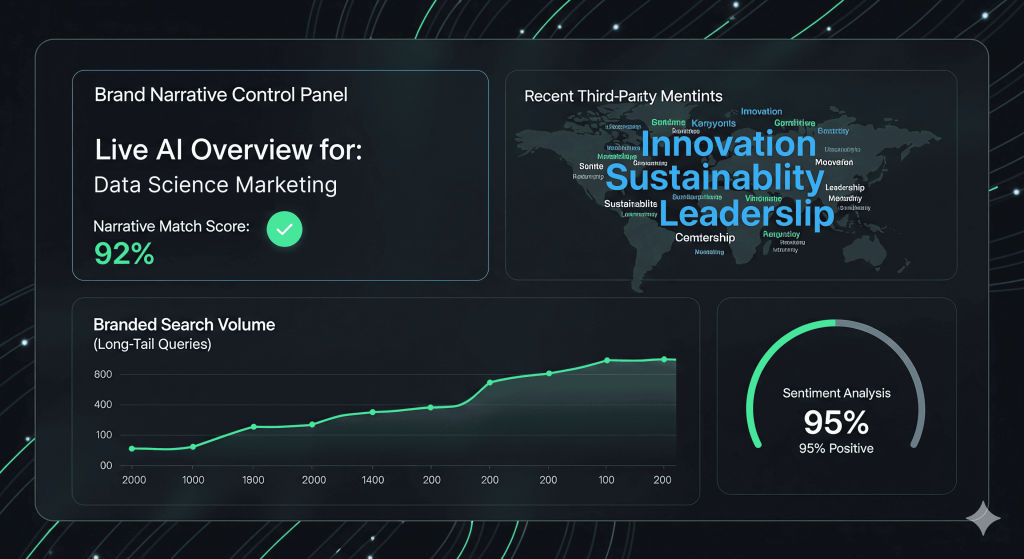An AI has just defined your brand to a potential customer. It delivered a concise, authoritative-sounding summary of who you are, what you do, and why you matter. You had no direct input. You were not consulted. Yet, that AI-generated text is now the functional reality for that user. This is the central marketing challenge of 2025.

For two decades, we optimized for position on a list. Today, that is a solved problem with diminishing returns. The new imperative is to optimize for synthesis. When a large language model (LLM) scours the entire digital universe to form an opinion about you, your brand’s survival depends on controlling the narrative it discovers.
This is not about tricking an algorithm. It is about a deliberate, disciplined, and relentless process of engineering a digital consensus so strong that an AI has no choice but to repeat your truth. This is your guide to controlling what a robot says about you.
Your new brand manager is a Large Language Model
First, we must disabuse ourselves of the notion that these models “think” or “understand.” They do not. An LLM is a massively complex pattern-recognition and prediction engine. When asked about your brand, it performs a high-speed synthesis of the information it has been trained on—which is, for all practical purposes, the internet.
The AI’s summary of your brand is a mirror. It is a reflection of the signals you and others have broadcasted across the web. These signals include the explicit text on your website, the structured data in your knowledge graph, the language used in your press coverage, the sentiment of your customer reviews, and the conversations happening about you on forums and social media.
If you do not like the reflection, you cannot argue with the mirror. You must change the object being reflected.
This requires a fundamental evolution of our discipline, moving from Search Engine Optimization (SEO) to what is more accurately described as Knowledge Ecosystem Optimization (KEO). The goal is no longer to rank a page, but to saturate your entire digital ecosystem with a consistent, factual, and compelling narrative that the AI will inevitably find and synthesize. Your job is to make your desired narrative the most logical, well-supported conclusion.
Deconstructing the AI's 'brain': the hierarchy of truth
To influence the AI’s output, you must understand its inputs. While the exact weighting is proprietary, we can infer a clear hierarchy of sources that models use to establish “truth.” Your strategy must be to dominate each tier of this hierarchy.
Tier 1: Owned and directly-influenced entities
This is the foundation. These are the digital assets where you have the highest degree of control. The AI treats these as canonical, foundational sources of fact about your entity. Any inconsistencies here will dilute the authority of your entire narrative.
Your website: Specifically your ‘About Us’, company history, leadership, and product pages. These can no longer be marketing-fluff repositories. They must be treated as factual, citable documents written with encyclopedic clarity.
Your knowledge graph: This includes your Google Business Profile, but extends far beyond it. It is the structured data (like Schema.org markup) on your site that explicitly defines who you are, what you sell, who founded you, and what you are an authority on.
Wikidata and Wikipedia: A factually accurate, neutrally-toned Wikipedia page, supported by a robust Wikidata entry, is one of the most powerful signals of truth you can have. While you cannot directly write your own page, you can ensure the public information available for editors is impeccable.
Tier 2: High-authority third-party validation
This is where your foundational facts are validated by trusted, external sources. The AI looks for corroboration here to confirm that what you say about yourself is acknowledged by others.
Major industry publications: A feature in Forbes, a positive analysis from Gartner, or a review in a top-tier industry journal. The key is not the “backlink,” but the language of the coverage.
Authoritative review platforms: For B2B, this is G2, Capterra, and Gartner Peer Insights. For B2C, it’s sources like Consumer Reports or Trustpilot. The aggregate sentiment and specific phrases used in these reviews are powerful inputs.
Reputable news outlets and data sources: Mentions in The Wall Street Journal, Bloomberg, or being cited as a data source by government or academic institutions.
Tier 3: The general web corpus and public discourse
This is the broadest and messiest tier, but it is where consensus at scale is built. The AI ingests everything: forum discussions, social media conversations, blog comments, and the long tail of customer reviews.
Forums and communities: What is the consensus about you on Reddit, Quora, or Stack Overflow? Are users recommending your product as a solution?
Social media: How are influencers, customers, and even employees talking about your brand?
Unlinked mentions: The text used to describe your brand across thousands of smaller blogs and websites, even without a direct link.
Your strategy is simple to state but difficult to execute: achieve absolute consistency in Tier 1, use digital PR and content marketing to earn corroboration in Tier 2, and shape the public conversation to build consensus in Tier 3.

The tactical playbook for narrative control
This is not a passive exercise. It is an active process of information warfare where your opponent is ambiguity and misinformation.
Step 1: Define your canonical narrative
Before you begin, you must decide what you want the robot to say. Distill your brand’s identity into a set of non-negotiable, citable facts. What are the three to five statements that, if repeated by an AI, would constitute a victory?
Example for a SaaS company:
“SynthAI is the leading platform for real-time supply chain analytics for enterprise CPG brands.”
“It was founded in 2019 by former Google AI researcher Dr. Anya Sharma.”
“The platform is known for its proprietary ‘Predictive Logistics Engine,’ which reduces shipping waste by an average of 12% for its clients.”
This is your internal source of truth. Every subsequent action must be designed to get the digital world, and therefore the AI, to repeat these statements.
Step 2: Engineer your foundational entities (Tier 1)
Treat your brand as a database entity. Your website’s ‘About’ page must state your canonical narrative in clear, unambiguous language. Use Organization schema to define your legal name, founding date, founders, and industry. Use Person schema for your executives, linking them to their roles and credentials. Every product page needs detailed Product schema with features and benefits stated as factual attributes. Scour your Google Business Profile and ensure every single field is filled out and perfectly aligned with your website and Wikidata entry. This is the painstaking, unglamorous work that builds the bedrock of your AI-driven reputation.
Step 3: Weaponize digital PR and content (Tier 2)
Your digital public relations team’s goal is no longer just “media placements” or “backlinks.” Their new primary key performance indicator is narrative adoption. When you pitch a story to a journalist, provide them with your citable, canonical facts. The victory isn’t getting mentioned; it’s getting your desired phrasing quoted.
Furthermore, publish original research. Instead of a blog post titled “Why Supply Chains Are Important,” publish “The 2025 State of CPG Logistics Report.” Fill it with data, charts, and analysis. This makes you the primary source, the citable authority that both journalists and AI models will reference when discussing your industry.
Step 4: Manufacture consensus at scale (Tier 3)
Consensus is the aggregation of countless small conversations. You must shape these conversations. Implement a systematic review generation program that encourages satisfied customers to leave detailed reviews. Do not ask for “a 5-star review.” Ask them to “share how our Predictive Logistics Engine has impacted your shipping efficiency.” This seeds the public discourse with your canonical language.
Engage in relevant communities like Reddit and industry forums. Do not spam your product. Answer questions authoritatively and, where appropriate, mention how a specific feature of your product solves the user’s problem. Every helpful, accurate answer becomes another data point reinforcing your expertise and narrative.
Measuring success in a narrative-driven world
The old dashboards are obsolete. Rank tracking and organic traffic are now lagging, incomplete indicators. Your new measurement framework must be qualitative and focused on narrative alignment.
Brand SERP analysis: This is your new homepage. Regularly perform searches for your brand name, “is [Your Brand] good,” “[Your Brand] vs [Competitor],” and other key queries. Screenshot and log the AI Overview. Does it match your canonical narrative? Is it positive? Is it accurate? This is your most important KPI. Tools from experts like Jason Barnard at Kalicube are essential for tracking and improving this.
Narrative mention tracking: Use advanced brand monitoring tools (e.g., Brand24, Talkwalker) to track not just mentions, but the context of those mentions. Are publications and users repeating your key phrases? Is the sentiment around your “Predictive Logistics Engine” positive?
Branded search volume: An increase in highly specific, long-tail branded searches (e.g., “SynthAI predictive logistics case study”) is a strong signal that the AI Overviews are successfully educating the market at the top of the funnel and driving qualified, direct interest.
You cannot opt out of this. Right now, as of September 2025, an AI is defining your brand to customers, partners, and potential hires. The web has formed an opinion, and the robots are repeating it. The only choice you have is whether you allow that opinion to be formed by accident, or you engineer it on purpose.

